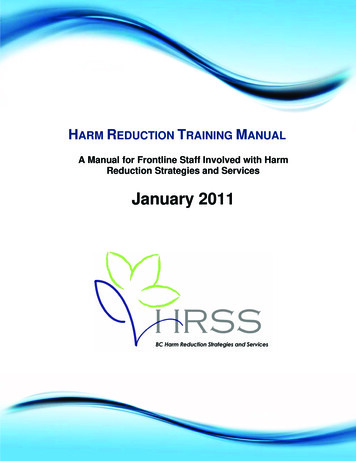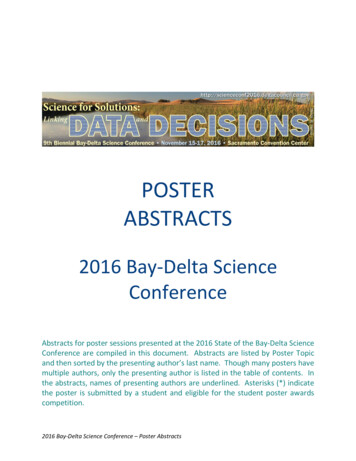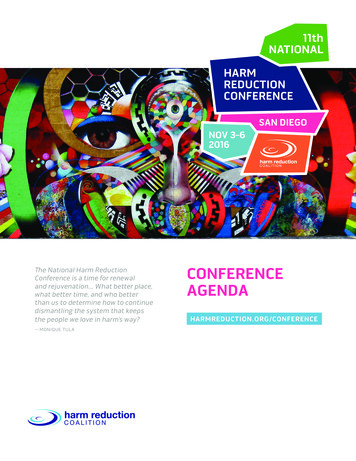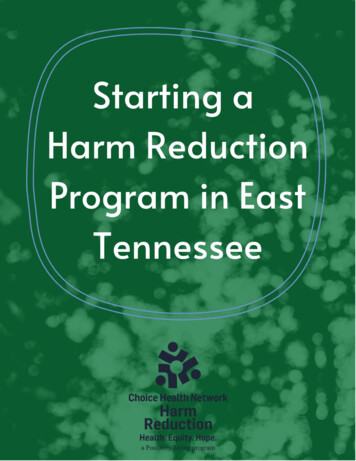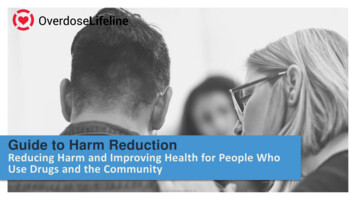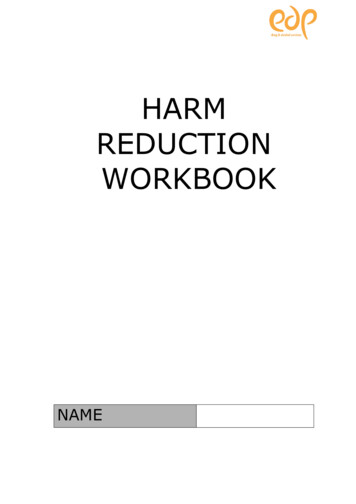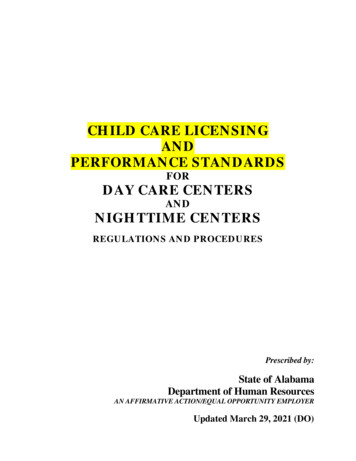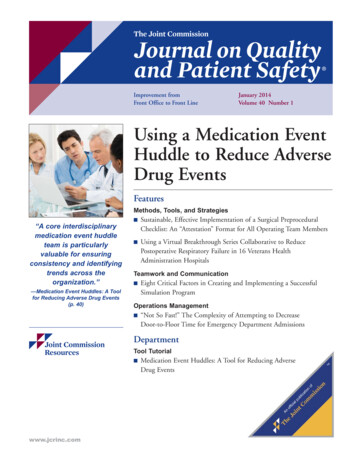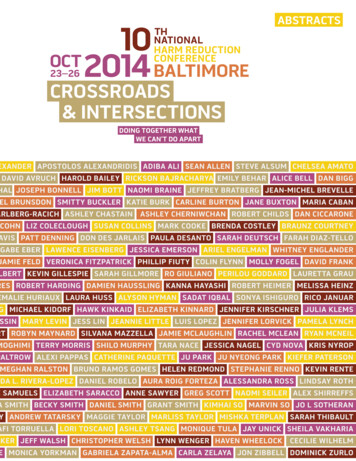
Transcription
ABSTRACTS
CONFERENCE 2014ABSTRACTSThis is a listing of all presenters and presentation abstracts that weresubmitted to Harm Reduction Coalition when registering for the conference.Mission StatementHarm Reduction Coalition is a national advocacy and capacity-buildingorganization that promotes the health and dignity of individuals andcommunities impacted by drug use. Our efforts advance harm reductionpolicies, practices and programs that address the adverse effects of drug useincluding overdose, HIV, hepatitis C, addiction, and incarceration. Recognizingthat social inequality and injustice magnify drug-related harm and limit thevoice of our most vulnerable communities, we work to uphold everyindividual’s right to health and well-being and their competence toparticipate in the public policy dialogue.Conference Objectives Provide a safe forum for the exchange of information, ideas, and strategies forincorporating harm reduction into direct services, public policy, and individuallives Offer technical information on program development and implementation Present current examples of effective harm reduction services and policies Encourage a dialogue between individuals from diverse disciplines,backgrounds, and personal experiences, including drug users and those witha history of drug use Explore and analyze our own attitudes about and relationships to drugs anddrug usersDownload this document online at:www.harmreduction.org/conference1 Harm Reduction Conference 2014: Abstracts
AAgostini, SaidaFreestate Legal ProjectCo-Author(s):Dominique Parris, SMYAL,Saida Agostini,FreeState Legal ProjectDominique Parris, M.EdOriginally from outside ofPhiladelphia, Dominique earned herB.A. in International Relations fromWellesley College and her M.Ed.in Social Justice Education fromthe University of MassachusettsAmherst. Her graduate studiesallowed Dominique to focus onissues of race, gender and sexualorientation and further develop herskills and passion for curriculumdesign, dialogue facilitation, andpopular education techniques.While earning her M.Ed, Dominiquesupervised Peer Mentors as a partof the First Year Education programin the department of Residence Lifeat UMass Amherst. She especiallyenjoyed the opportunity to workclosely with youth as they educatedand empowerAgus, DeborahBehavioral Health LeadershipINstituteCo-Author(s):Coriless Jones, Dee’s Place,Lena Franklin, Recovery in CommunityDeborah Agus received her lawdegree from Cornell Law Schoolin 1979 and has spent most of hercareer in field of public mental healthpolicy. As Counsel and Director ofPolicy at Baltimore Mental HealthSystems, Inc., the local mentalhealth authority for Baltimore City,Deborah designed and implementeda case rate pilot project for personssuffering from serious and persistentmental illness who were targetedas the State’s heaviest users anda system-wide crisis service. Afterleaving BMHS, she served as aconsultant to local governmentson issues of system design andalso helped to develop case ratemodels in other jurisdictions. She iscurrently the Executive Director ofthe Behavioral Health LeadershipInstitute.2 Harm Reduction Conference 2014: AbstractsNarratives of Power and Resistance: Partnering with LGBTQ Youthand Families to Build Best PracticesBest practices are typically constructed using data collected from massivestudies that often relegates the stories of LGBTQ youth, families and otheradvocates in the margins. SMYAL (Supporting and Mentoring Youth Advocatesand Leaders) and FreeState Legal Project have partnered together to constructbest practices for service providers, educators, and other stakeholders, that aregrounded in the rituals of resiliency that have helped LGBTQ youth overcomemultiple oppressive barriers. The workshop will highlight new models for peerengagement, discuss the importance of creating best practices that utilizestorytelling, and are grounded in resiliency. The facilitators will also discuss thecultural shift required to ground best practices in a celebration of resiliencyand agency, as opposed to pathology, and what it means to partner with LGBTQyouth and families to codify these narratives.Reaching Out to Reach In: Providing Buprenorphine Treatment inGrassroots SettingsOpioid addiction is a devastating health problem especially for peopleliving in poverty. There is a need to increase access to effective treatments.Buprenorphine is a highly effective medication that is used in the outpatienttreatment of opioid-dependent patients but is under-utilized due to sharedstigma on the part of users, clinicians and policy-makers and additional barriers to access including rigid programs and unwelcoming providers. The BHLImodel is to co-locate high-quality professionals within a community-basedpeer recovery setting, thus integrating medical treatment with support bypeers and paraprofessionals. The focus is on treating the addiction with a nonjudgmental, open approach. The treatment is included within a program thatincludes participation in recovery meetings, counseling and optional yoga. Thetwo recovery sites are Dee’s Place and Recovery in Community, each of whichare peer-managed thresholds to recovery sites. The presentation panel willinclude a client from the program who now works with new clients to supporttheir recovery, a peer recovery outreach specialist from the site, the Directorof Recovery in Community and a member of the clinical team. The panel willexplain how the model works so that it can be expanded to provide effectivetreatment while promoting hope and recovery.
AAkers, NaomiSt. James InfirmaryCo-Author(s):Stephany Ashley, St. James InfirmaryNaomi Akers, MPH, has worked as asex worker rights advocate in SanFrancisco for 20 years. For 7 yearsshe was the Executive Director ofthe St. James Infirmary (SJI), afree medical clinic for sex workerswhere she has worked since 2002,and has been a client since 1999.Naomi’s areas of interest centeraround harm reduction approaches,social justice and health as a humanright, particularly for Sex Workers,and drug users. Since 2012 NaomiAkers has served as a Commissioneron San Francisco’s EntertainmentCommission. In October 2013Naomi transitioned from her role asExecutive Director to the St. JamesInfirmary Board of Directors.3 Harm Reduction Conference 2014: AbstractsNo Condoms as Evidence Campaigns: Why what should be a “nobrainer” is actually an uphill political and legal battleThroughout the United States, law enforcement agencies confiscate condomsas evidence of prostitution and prostitution related crimes. As a result of advocacy by St. James Infirmary founding members (then with COYOTE) and othersex worker rights activists, in 1994, the San Francisco Board of Supervisorssigned a resolution urging the San Francisco Police Department (SFPD) andthe San Francisco District Attorney (SFDA) to discontinue this practice as itdiscourages the use of condoms, undermines the City’s current policy and thelabors of health professionals, and counters the efforts behind the enactmentof San Francisco’s “State of Emergency” (the same policy that paved the way forsyringe access programs in San Francisco). Then District Attorney Arlo Smithsigned an agreement that the DAs Office would not use condoms as evidencefor 647(b) cases (soliciting for prostitution, State CA Penal Code) as an “act offurtherance”. This agreement was on a trial basis and was intended to includean active review with the Health Department and Police Department on theresults of the demonstration agreement. The review never occurred. The agreement was honored by the SFDA for many years, however under the leadership ofKamala Harris in 2003 the agreement was disregarded. Over the next 10 years,the confiscation, photographing and use of condoms as evidence by the SFPD,SFDA and the ABC (Alcohol Beverage & Control) against sex workers and groupsprofiled as sex workers proliferated. St. James Infirmary began an 8-year battleurging the City to resume the 1994 resolution and SFDA agreement. Finally, asa result of collaboration between Human Rights Watch, the SF Human RightsCommission and the SF AIDS Office, in April 2013 the SFPD and the SFDA agreedto not use condoms as evidence of soliciting or loitering in prostitution relatedcases. This presentation will provide an overview of the use of condoms asevidence in 4 major cities and then outline the history of this political battle inSF, the steps involved, the benefits and challenges of the collaborations, andwill also include data related to a 90 day review of prostitution cases withoutthe use of condoms as evidence. Furthermore the St. James Infirmary presenters will examine the pros and cons of a pending/current California bill to endthe statewide use of condoms as evidence and discuss the ongoing efforts toevaluate the outcomes of the “no condoms as evidence” policy change amongsex workers and those targeted as such in San Francisco.
AAlbizu-Garcia, CarmenGraduate School of Public Health,UPRCo-Author(s):Carmen E. Albizu-Garcia, GraduateSchool Public Health, UPR,Angelita Negron, Mental Health andAnti-Addiction Services Adm., PR,Myribel Santiago, Mental Health andAnti-Addiction Services Adm., PR,Nancy Vega-Ramos, Vital Records,Puerto Rico Department of Health,Patricia Vélez, Forensic SciencesInstitute, Puerto RicoMy academic career has beencharacterized by a strongcommitment to training healthprofessionals sensitive to populationneeds and capable of understandingthe contributions of research topolicy and services. I dedicated agreat deal of my effort during mytenure as Academic Dean in twomedical schools in Puerto Rico tothe incorporation in the curriculumof a bio-psycho-social model fromwhich to comprehend and managehealth and illness. From theseleadership positions I also gained anunderstanding of the complexitiesof academic institutions and thechallenges that one must overcometo promote change and innovation.4 Harm Reduction Conference 2014: AbstractsThe Declining Trend in Drug Overdose Deaths in Puerto RicoFatal and non-fatal overdose events are preventable. Between 1990 and 2000,the rate of overdose deaths in Puerto Rico (PR) nearly tripled and by the end ofthe decade attained a rate three times greater than that reported for the USpopulation. The rate of overdose deaths in the US has markedly increased withmany deaths accounted for by misuse of prescription pain killers, which has ledhealth authorities to address overdose deaths as a prevention priority. Duringthe last decade Puerto Rico had not been monitoring fatal and non-fatal accidental overdose events in spite of the rising trend experienced previously. InDecember of 2013, the Administrator of the MHAASA convened an inter-publicagencies work-group and academia to address the need for data that quantifiesthe number of deaths and identifies factors associated with overdose eventsfrom illicit drugs and medications to inform policy and prevention. Analysisof deaths from the PR Forensic Institute and preliminary analysis of VitalStatistics for the period 2000-2012 reveal a marked decrease in OD mortalityin the Island. We will present overall standardized rates of OD mortality as wellas by gender and age groups. We will present and discuss preliminary data thatmay support potential explanations for the observed trend.
AAlexander, IrinaAt The CrossroadsCo-Author(s):Lauren Johnson, At The Crossroads,Berkeley Needle Exchange,Irina Alexander, At The Crossroads,Youth Rise,Brun Gonzalez, Espolea, Youth Rise,Jenna Mellor, Covenant HouseLauren “LJ” Johnson is an OutreachCounselor with At The Crossroads,a support organization that workswith homeless youth and youngadults in San Francisco, CA . She isalso a member of Berkeley NeedleExchange Emergency Distribution.Irina Alexander’s currently anOutreach Counselor with At TheCrossroads, sits on the InternationalWorking Group of Youth Rise, andalso does psychedelic harm reductionwork through MAPS.Jenna is a former Outreach Managerat HIPS and currently works asa Global Health Corps Fellow atCovenant House.Brun is the Harm ReductionCoordinator with Espolea, a harmreduction organization in MexicoCity, and is also a member of YouthRise.5 Harm Reduction Conference 2014: AbstractsThe Heart of Harm Reduction: Individualizing Services to MeetClients’ NeedsA client-centered approach prioritizes the knowledge, experience, and abilitiesof individuals while working to support them moving towards their self-directedgoals. While many nonprofits understand this type of approach to be at the coreof their direct service work, both structural and organizational barriers preventthis buzzword from becoming a reality. Incorporating perspectives from multiple agencies, this session will discuss various strategies for moving organizations towards a more client centered model. Expanding the application of harmreduction practice, we will discuss various approaches to supporting clientswith a focus on mental health, substance use, and street economies.”
AAlexandridis,ApostolosUNC Injury Prevention ResearchCenterCo-Author(s):Nidhi Sachdeva, UNC InjuryPrevention Research Center,Nabarun Dasgupta, UNC InjuryPrevention Research Center,Michael Dolan Fliss, Orange CountyHealth Department (NC),Kathleen Clark, IndependentConsultant,Robert BB Childs, North CarolinaHarm Reduction Coalition,Co-PresenterWe are a team of researchersand public health practitionersworking to increase access tonaloxone in North Carolina. Ourteam consists of academics, harmreduction advocates, communityoutreach workers, and local healthdepartments. Though we havediverse affiliations, we are united inour common goal of reducing opioidoverdose in North Carolina.Tracking and Understanding Naloxone Use and Overdose ReversalStatewide in North CarolinaBackground: Many questions concerning the use of naloxone in communitysettings remain unanswered, including: the method of administration, involvement of EMS and law enforcement, gender and age of overdose victims, timingof doses, and the origin of the naloxone used.Methods: We have designed a system to label most naloxone kits distributed inNorth Carolina with unique ID codes that include distributing county and entity(e.g. Local Health Department or North Carolina Harm Reduction Coalition(NCHRC)). These labels also contain a link to a short, online, anonymous surveyfor adults who have used the kit to reverse an overdose.Because of our existing efforts to evaluate overdose prevention programsstatewide, the most crucial questions of naloxone use, location and date of use,were placed at the beginning.Revisions to the initial survey questions were influenced by a review of thequestions with the NCHRC Users Group and community stakeholders. We programmed the survey using Qualtrics Survey Software.The survey is embedded in a website that could also act as a clearinghouse forinformation on naloxone access, legislation, and use.Discussion: Several compromises were made in our survey. Our questions, initially chronologically ordered, were reordered by relevance to our research teamto account for the likelihood of incomplete surveys.It was also important to devise questions that would be applicable to all opioidusers, including injection drug users and users of prescription analgesics. Theformer population is smaller, but has a higher risk of overdose (SAMHSA 2013,Seal 2011).We expect our ID system to increase the fidelity of county-of-origin information.The ability to identify where naloxone kits originated and where they are usedwill enable us to determine the most efficacious methods of naloxone distribution by local government agencies and statewide NGOs.References: Seal KH. 2001. Predictors and prevention of nonfatal overdoseamong street-recruited injection heroin users in the San Francisco Bay Area,1998-1999. American journal of public health, 91(11), 1842-6.Substance Abuse and Mental Health Services Administration (SAMHSA). 2013.Results from the 2012 National Survey on Drug Use and Health: Summary ofNational Findings, NSDUH Series H-46, HHS Publication No. (SMA) 13-4795.Rockville, MD: Substance Abuse and Mental Health Services Administration.6 Harm Reduction Conference 2014: Abstracts
AAli, AdibaClark County Public HealthCo-Author(s):Sandi Kendrick,Clark County Public HealthSandi Kendrick has been a healtheducator with Clark County PublicHealth for her entire career of 35years. She has a BA in CommunityHealth Education. She has beeneducating youth, adults andcommunity members throughouther career on sexuality and harmreduction. She has always strivedto give vulnerable adults andyouth a voice and a safe place toget information, share storiesand become empowered to helpthemselves.Adiba Ali is an epidemiologist at ClarkCounty Public Health, in Vancouver,WA. As a program evaluator, sheworks closely with the syringeservices program, and is passionateabout reducing harm among ourmost vulnerable citizens.7 Harm Reduction Conference 2014: AbstractsSaving Lives with the Overdose Prevention Program in Clark County,Washington.Background: The Clark County Harm Reduction Center in Vancouver, WAincludes syringe exchange, health screenings, and referrals to communityresources such as health care, drug treatment, and social services. Statementof Problem: Opioid-related deaths and hospitalizations have significantlyincreased in the last several years. Strategies/Methods: Clark County PublicHealth initiated an overdose prevention program to provide education and distribute naloxone, a medication that reverses opioid overdoses. Harm ReductionCenter staff, volunteers, and clients are receiving overdose managementtraining, and under the prescribing authority of the Health Officer, naloxoneis distributed to persons at risk for having or witnessing an opioid overdose.Partners: Key partners, including homeless youth outreach and law enforcement agencies, have supported overdose prevention efforts through referrals and increasing community awareness and education. Evaluation results:Training effectiveness is being evaluated through participant surveys, and overdose reversals are being tracked through naloxone program enrollment andrefill forms. Through collaborations with Vital Records and Emergency MedicalServices, we expect to track real-time overdose-related deaths and local use ofnaloxone. Conclusions: Providing overdose prevention tools to at-risk individuals can reduce opioid-related deaths, increase access to care, and enhance community awareness and education.
AAllen, SeanThe George Washington UniversityCo-Author(s):Monica Ruiz,The George Washington University,Allison O’Rourke,The George Washington UniversitySean Allen, MPH, DrPH(c), is agraduate student in the Doctorof Public Health (DrPH) programin Health Behavior at the MilkenInstitute School of Public Health atThe George Washington University inWashington, DC. He currently servesas a Research Associate on a study(PI: Monica Ruiz) that explores policychange as a structural interventionfor HIV prevention among injectiondrug users in three US cities(Baltimore, MD, Philadelphia, PA, andWashington, DC). Mr. Allen’s currentresearch interests include usingmixed-methods analyses to examinesubstance use and high risk sexualbehaviors, with specific attentionon the role of spatial access toharm reduction services for HIVprevention.The Evidence Does Not Speak for Itself: The Role of ResearchEvidence in Shaping Policy Change for the Implementation of PubliclyFunded Syringe Exchange Programs in Three US CitiesBackground: Policies that facilitate the creation and implementation of structural interventions for HIV prevention, such as syringe exchange programs, mayhelp lower HIV incidence among injection drug users (IDU). Ideally, public healthpolicies are informed by research evidence; however, the role of evidence inshaping public policy is dependent on a variety of factors, including the interpretation of research findings and windows for policy change. Though existingstudies have explored the role of research evidence in policy change processes,few focus on its use in shaping policies for harm reduction programs that serveIDU. Studies on applications of research evidence frequently divide its useamong three typologies: instrumental, conceptual, and symbolic. Using thesetypologies as a framework, this study examined the role of research evidencein shaping policy change for the implementation of publicly funded syringeexchange services in three US cities: Baltimore, MD, Philadelphia, PA, and theDistrict of Columbia (DC).Methods: In-depth qualitative interviews were conducted with key stakeholders(N 29) from each of the three cities. Stakeholders were asked about historical, social, political, and scientific contexts in place prior to, during, and afterthe policy change event in their city. Interviews were transcribed, coded, andanalyzed for common themes pertaining to applications of research evidence inpolicy change processes.Results: In Baltimore and Philadelphia, the typological approaches to theapplications of research evidence used (instrumental and symbolic/conceptual,respectively) by syringe exchange proponents were effective in producing thepolitical momentum required to facilitate policy change processes that allowedfor the implementation of syringe exchange services. Applications of researchevidence were less successful in DC because legislative decision-making wasdriven more by political ideologies opposing harm reduction strategies thanobjective consideration of research evidence supporting the public health utility of syringe exchange services.Conclusion: While typological applications of research evidence are useful forunderstanding policy change processes, their efficacy falls short when policymakers ignore the merits of scientific research. Advocates for policy interventions for HIV prevention may benefit from understanding the utility of applications of research evidence and how each typology may be used to overcomelegislative hurdles.Note: This abstract is part of a suggested panel, “SEP in the City.”Missed Opportunities for Harm Reduction: Using GIS to Understandthe Impact of Policies That Restrict Needle Exchange ServicesBackground: Syringe exchange programs (SEPs) have been shown to reducetransmission of HIV among injection drug users (IDU). Policies related to theirimplementation and operation may place severe restrictions on their servicedelivery. In the District of Columbia (DC), SEPs are prohibited “within 1,000 feetof a public or private elementary or secondary school (including a public charterschool).” This policy restriction is damning for SEPs given that DC had morethan 200 schools in operation during the 2013-2014 school year and that theDistrict is a mere 68.5 sq. miles. Further, DC is divided into 8 wards that haveunequal burdens of HIV infection. This study uses GIS mapping to understandthe relationship between areas impacted by the 1,000-foot rule ban and wardswith greatest prevalence of persons living with HIV.Methods: Data from the DC Geographic Information System (DC-GIS) were usedto overlay bodies of water and areas under federal jurisdiction (national parksand military installations) that prohibit SEP activities. Data from the DC Public8 Harm Reduction Conference 2014: Abstracts
AAllen, Sean (continued)Charter School Board, DC Public Schools, and Independent Education were usedto geocode locations for charter schools, public schools, and private schools,respectively, that met the criteria of the 1,000-foot rule. Preliminary geocoding was conducted using a program developed by the DC Office of the ChiefTechnology Officer that matched schools to the DC Master Address Repository(MAR). This matching process output identifiers of each school location thatwere then matched to a dataset from DC-GIS that geocoded the physical property boundaries of each school location. A 1,000-foot buffer was then appliedto each of the school property boundaries. Geospatial analyses were conductedto determine the impact of policy restrictions on SEP service delivery areasin each ward and compared to 2012 HIV prevalence data by ward from the DCDepartment of Health.Results: Bodies of water, national parks, and military installations resulted in aloss of 7.3, 10.7, and 2.8 sq. miles, respectively, or 30.4% of the total area of DCwhere SEPs can operate, which left 47.7 sq. miles as potential SEP operationalspace. Among the schools that met the criteria of the 1,000-foot rule (n 227),99.6% (n 226) generated matches to the DC MAR. Applying a 1,000-foot bufferaround school property boundaries resulted in a total loss of an additional25.2 sq. miles of potential SEP operational space. This means that the policyprohibits SEPs in 52.8% of the total potential SEP operational space in DC.Paradoxically, ward 3, which has the lowest HIV prevalence in DC, has only 37.8%of its potential SEP operational space banned due to school proximity, whileward 1, which has the greatest prevalence of HIV in DC, has 78.2% of its potentialSEP operational space banned due to school proximity.Conclusions: The disconnect between wards with the greatest prevalence of HIVand areas where SEP service provision is legal creates missed opportunities forHIV prevention. Policy reform efforts should focus on revising restrictions thatplace unnecessary burdens on access to harm reduction services.”How far will they go?: Assessing the travel distance of current andformer IDU to access harm reduction servicesBackground Utilization of syringe exchange programs (SEPs) offer significantbenefits to injection drug using (IDU) populations who often experience stigmatization, financial barriers, and other disincentives when trying to seek carefrom traditional medical providers. Because these programs offer more userfriendly services, it is not uncommon for clients to seek out these services, evenwhen other services are available and located more conveniently. While priorresearch has explored spatial access to SEPs among active IDU, there is littleinformation available about service utilization at SEP sites by former IDU. Thisis an important gap in the literature given the cyclical nature of addiction andthat drug users may experience positive health outcomes when engaging withproviders who understand their substance use history. This study uses datacollected as part of an IDU population estimation study in Washington, DC toexamine differences in geographical access between active and non-active IDUseeking services at a mobile SEP.Methods: Data from an IDU population estimation study that took place duringMarch and April 2014 in Washington, DC were used to measure walking distancefrom residence to the mobile exchange site where a person engaged with theSEP. There are two mobile exchange sites in DC; for this analysis, only data fromthe largest mobile exchange program were used. Mobile exchange sites werematched to a corresponding address using Google Maps. To protect the clients’anonymity, data on home zip codes (but not addresses) were collected. ArcGISwas used to calculate latitude and longitude coordinates for the centroid pointsin each zip code. A SAS macro was then created that used Google Maps to ploteach pair of data points (location of SEP site and centroid of home zip code) andcalculate walking distance. Independent samples t-tests were used to determine if statistically significant differences existed in walking distance measuresbetween persons who reported active IDU and those who reported no activeIDU in the past 30 days on the date of engagement with the SEP.9 Harm Reduction Conference 2014: Abstracts
AAllen, Sean (continued)Results: During the capture phase of the population estimation study, 201persons completed study forms at the mobile exchange site. Among thissample, 64 forms were excluded due to persons reporting residence outside ofWashington, DC and/or having missing data for the variables assessing engagement in injection drug use or zip code of residence. Distance calculations wereconducted on the remaining sample (n 137). Of these, 29.2% (n 40) reportednot injecting in the last 30 days. Differences in mean walking distance betweenactive and non-active injectors were statistically significant (p .05), with noninjectors having a mean walking distance of 1.80 miles and active injectorshaving a mean walking distance of 2.75 miles.Conclusions: The results of this study suggest that persons who are engagingwith SEPs primarily for non-needle exchange services (i.e. medical services)may be less willing to commute greater distances to access SEP services thantheir active IDU counterparts. This research provides support for expandingSEP operations such that non-IDU clients have shorter commutes to accessservices. Increasing service accessibility may help resolve unmet needs amongformer and active IDU.”Alsum, SteveThe Grand Rapids Red ProjectCo-Author(s):Brandon Hool,The Grand Rapids Red ProjectSteve Alsum is the Executive Directorof The Grand Rapids Red Project. Heserves as co-chair for the MichiganHIV/AIDS Council, serves on KentCounty’s Community Health AdvisoryCommittee, and as a board memberof Recovery Allies of West Michigan.Brandon Hool manages the CleanWorks syringe access program ofThe Grand Rapids Red Project. BothBrandon and Steve have personalexperience with overdose, as well asexperience training other communitymembers to prevent and respond tooverdose situations.Naloxone Distribution in Substance Use Disorder Treatment: LessonsLearned in a Small MidWestern CityThe Grand Rapids Red Project has been working to address overdose in GrandRapids, a small mid-western city, for the last 6 years. We began training clientsat our syringe access program, Clean Works, how to prevent and respond tooverdose situations with Naloxone in October of 2008. In 2013 our programsaw a major expansion, and we now provide overdose prevention and responsetraining, with and with-out N
at umass amherst. She especially enjoyed the opportunity to work closely with youth as they educated and empower A AGuS, Deborah Behavioral Health Leadership INstitute Co-author(s): Coriless Jones, Dee's Place, lena Franklin, Recovery in Community deborah agus received her law degree from Cornell law School in 1979 and has spent most of her
